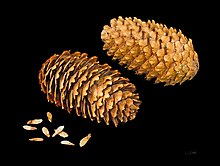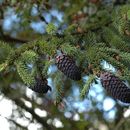Description
provided by eFloras
Trees to 50 m tall; trunk to 2.5 m d.b.h.; bark dull gray or brown-gray, breaking into thick, irregular plates; crown pyramidal; branchlets initially pale yellow or brownish yellow, finally gray or gray-yellow, often sparsely pubescent, rarely with glandular hairs; winter buds brown, conical, ovoid, or globose, resinous, scales not reflexed, or slightly opening at base of branchlets. Leaves directed forward on upper side of branchlets, spreading on lower side, linear, straight or slightly curved, ± broadly rhombic in cross section or subflattened, 0.6-1.5 cm × 1-1.5 mm, stomatal lines 4-7 along each surface adaxially, 0-4 along each surface abaxially, apex acute or obtuse. Seed cones reddish brown or purple, maturing brown, reddish brown, purplish brown, or dark purple, ovoid-oblong or ovoid-cylindric, 4-12 × 1.7-3.5 cm. Seed scales at middle of cones rhombic-ovate, 1.5-2.6 × 1-1.7 cm, base cuneate, margin denticulate or undulate, apical part narrowed into a triangular or obtusely triangular point. Seeds gray-brown, subovoid, 0.7-1.4 cm including wing; wing pale brown, lustrous, usually with purplish spots, obovate-oblong. Pollination Apr-May, seed maturity Sep-Oct.
- license
- cc-by-nc-sa-3.0
- copyright
- Missouri Botanical Garden, 4344 Shaw Boulevard, St. Louis, MO, 63110 USA
Distribution
provided by eFloras
S Qinghai, S and W Sichuan, E Xizang, NW Yunnan [Bhutan]
- license
- cc-by-nc-sa-3.0
- copyright
- Missouri Botanical Garden, 4344 Shaw Boulevard, St. Louis, MO, 63110 USA
Habitat
provided by eFloras
Mountains, ravines, river basins; 2500-4100 m.
- license
- cc-by-nc-sa-3.0
- copyright
- Missouri Botanical Garden, 4344 Shaw Boulevard, St. Louis, MO, 63110 USA
Cyclicity
provided by Plants of Tibet
Pollination from April to May; Seed maturity from September to October.
Distribution
provided by Plants of Tibet
Picea likiangensis is occurring in SW Sichuan, SE Xizang, NW Yunnan of China, Bhutan.
Evolution
provided by Plants of Tibet
The within-species genetic diversity and phylogenetic relationships of Picea likiangensis were investigated using polymorphic DNA (RAPD) markers in the Qinghai-Tibetan region (Peng et al., 2007). Results suggest that this species has high overall genetic diversity, with 85.42% of loci being polymorphic and an average expected heterozygosity (H E) of 0.239. However, there were relatively low levels of polymorphism at population levels and the differences between populations were not significant, with percentages of polymorphic bands (PPB) ranging from 46.88 to 69.76%, Nei’s gene diversity (H E) from 0.179 to 0.289 and Shannon’s indices (Hpop) from 0.267 to 0.421. In accordance with proposed hypothesis, a high level of genetic differentiation among populations was detected based on Nei’s genetic diversity (G ST = 0.256) and AMOVA analysis (Phi st = 0.236). Gene flow between populations was found to be limited (Nm = 1.4532) and far lower than reported for other conifer species with wide distribution ranges from other regions. No clusters corresponding to three morphological varieties found in the south, north and west, respectively, were detected in either UPGMA or PCO analyses. Results suggest that this species may have had different refugia during the glacial stages in the southern region and that the northern variety may have multiple origins from these different refugia.
General Description
provided by Plants of Tibet
Trees to 50 m tall; trunk to 2.5 m d.b.h.; bark dull gray or brown-gray, breaking into thick, irregular plates; crown pyramidal; branchlets initially pale yellow or brownish yellow, finally gray or gray-yellow, often sparsely pubescent, rarely with glandular hairs; winter buds brown, conical, ovoid, or globose, resinous, scales not reflexed, or slightly opening at base of branchlets. First-year branchlets usually slender, with nodes of normal length, sparsely pubescent. Leaves directed forward on upper side of branchlets, spreading on lower side, linear, straight or slightly curved, ± broadly rhombic in cross section or subflattened, 0.6-1.5 cm long, 1-1.5 mm wide, stomatal lines 4-7 along each surface adaxially, 2-4 along each surface abaxially, apex acute or obtuse. Seed cones red-brown or black-purple, maturing brown to reddish or blackish, ovoid-oblong or ovoid-cylindric, 7-12 cm. Seed scales at middle of cones rhombic-ovate, 1.5-2.6 × 1-1.7 cm, base cuneate, margin denticulate or undulate, apical part narrowed into a triangular or obtusely triangular point. Seeds gray-brown, subovoid, 0.7-1.4 cm including wing; wing pale brown, lustrous, usually with purplish spots, obovate-oblong.
Genetics
provided by Plants of Tibet
The chromosomal number of Picea likiangensis is 2n = 24 (Shi and Wang, 1994).
Habitat
provided by Plants of Tibet
Growing in mountains, river basins; 2500-3800 m.
Threats
provided by Plants of Tibet
Picea likiangensis is reported be lower risk/least concern (Conifer Specialist Group, 1998).
Uses
provided by Plants of Tibet
The timber of Picea likiangensis is used for construction, machines, poles, furniture, and wood pulp. The bark is used for producing tannin, the trunk for resin, and the leaves for aromatic oils.
Picea likiangensis
provided by wikipedia EN
Picea likiangensis, commonly known as Lijiang spruce, Lakiang spruce or Lijiang yunshan, is a species of spruce found in Bhutan and China.[1] Its population has been reduced by 30% in 75 years by logging, and the species is therefore categorised as vulnerable by the IUCN.[1]

Cones of
Picea likiangensis
References
- license
- cc-by-sa-3.0
- copyright
- Wikipedia authors and editors
Picea likiangensis: Brief Summary
provided by wikipedia EN
Picea likiangensis, commonly known as Lijiang spruce, Lakiang spruce or Lijiang yunshan, is a species of spruce found in Bhutan and China. Its population has been reduced by 30% in 75 years by logging, and the species is therefore categorised as vulnerable by the IUCN.

Cones of Picea likiangensis
- license
- cc-by-sa-3.0
- copyright
- Wikipedia authors and editors


 Cones of Picea likiangensis
Cones of Picea likiangensis